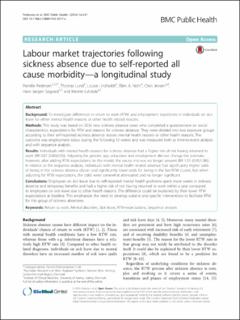| dc.contributor.author | Pedersen, Pernille | |
| dc.contributor.author | Lund, Thomas | |
| dc.contributor.author | Lindholdt, Louise | |
| dc.contributor.author | Nohr, Ellen A | |
| dc.contributor.author | Jensen, Chris | |
| dc.contributor.author | Søgaard, Hans Jørgen | |
| dc.contributor.author | Labriola, Merete | |
| dc.date.accessioned | 2020-04-27T12:58:22Z | |
| dc.date.available | 2020-04-27T12:58:22Z | |
| dc.date.created | 2016-12-14T14:50:34Z | |
| dc.date.issued | 2016 | |
| dc.identifier.citation | BMC Public Health. 2016, 16 (337), | en_US |
| dc.identifier.issn | 1471-2458 | |
| dc.identifier.uri | https://hdl.handle.net/11250/2652661 | |
| dc.description.abstract | Background
To investigate differences in return to work (RTW) and employment trajectories in individuals on sick leave for either mental health reasons or other health related reasons.
Methods
This study was based on 2036 new sickness absence cases who completed a questionnaire on social characteristics, expectations for RTW and reasons for sickness absence. They were divided into two exposure groups according to their self-reported sickness absence reason: mental health reasons or other health reasons. The outcome was employment status during the following 51 weeks and was measured both as time-to-event analysis and with sequence analysis.
Results
Individuals with mental health reasons for sickness absence had a higher risk of not having returned to work (RR 0.87 (0.80;0.93)). Adjusting for gender, age, education and employment did not change the estimate, however, after adding RTW expectations to the model, the excess risk was no longer present (RR 1.01 (0.95;1.08)). In relation to the sequence analysis, individuals with mental health related absence had significantly higher odds of being in the sickness absence cluster and significantly lower odds for being in the fast RTW cluster, but when adjusting for RTW expectations, the odds were somewhat attenuated and no longer significant.
Conclusions
Employees on sick leave due to self-reported mental health problems spent more weeks in sickness absence and temporary benefits and had a higher risk of not having returned to work within a year compared to employees on sick leave due to other health reasons. The difference could be explained by their lower RTW expectations at baseline. This emphasises the need to develop suitable and specific interventions to facilitate RTW for this group of sickness absentees. | en_US |
| dc.language.iso | eng | en_US |
| dc.publisher | BioMed Central | en_US |
| dc.rights | Navngivelse 4.0 Internasjonal | * |
| dc.rights.uri | http://creativecommons.org/licenses/by/4.0/deed.no | * |
| dc.title | Labour market trajectories following sickness absence due to self-reported all cause morbidity - A longitudinal study | en_US |
| dc.type | Peer reviewed | en_US |
| dc.type | Journal article | en_US |
| dc.description.version | publishedVersion | en_US |
| dc.source.volume | 16 | en_US |
| dc.source.journal | BMC Public Health | en_US |
| dc.source.issue | 337 | en_US |
| dc.identifier.doi | 10.1186/s12889-016-3017-x | |
| dc.identifier.cristin | 1412801 | |
| dc.description.localcode | Open Access This article is distributed under the terms of the Creative Commons Attribution 4.0 International License (http://creativecommons.org/licenses/by/4.0/), which permits unrestricted use, distribution, and reproduction in any medium, provided you give appropriate credit to the original author(s) and the source, provide a link to the Creative Commons license, and indicate if changes were made. The Creative Commons Public Domain Dedication waiver (http://creativecommons.org/publicdomain/zero/1.0/) applies to the data made available in this article, unless otherwise stated. | en_US |
| cristin.ispublished | true | |
| cristin.fulltext | original | |
| cristin.qualitycode | 1 | |

